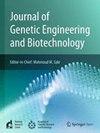Gut microbiome composition and diversity of wild-caught and hatchery-bred milkfish (Chanos chanos) fry
IF 2.8
Q3 Biochemistry, Genetics and Molecular Biology
Journal of Genetic Engineering and Biotechnology
Pub Date : 2025-06-11
DOI:10.1016/j.jgeb.2025.100520
引用次数: 0
Abstract
Milkfish is the most produced finfish in the Philippines, with approximately 75 % of its fry sourced from hatcheries. Despite numerous studies on gut microbiota of wild and cultured fish species, the diversity and functional roles of the milkfish fry gut microbiome remain poorly understood. This study presents the first gut microbiome profiles of wild and hatchery-bred milkfish fry using 16S rRNA amplicon analysis. A total of 437 OTUs were recovered and significant differences in gut bacterial communities among fry from different sources was observed, indicating that habitat is a key determinant of gut microbiome diversity. The core gut microbiota analysis identified Vibrionaceae and Roseobacteraceae as the most common and abundant bacterial families across fry sources. However, Paenibacillaceae and Bacillaceae under Phylum Bacillota were dominant in wild fry sources, particularly Hamtic and Kirayan, whereas families belonging to Phyla Cyanobacteriota, and Thermodesulfobacteria were more prevalent in Dumagas and Kirayan hatchery fry sources. Functional predictions of the gut bacterial microbiome revealed 26 differentially abundant pathways between wild-caught and hatchery-bred fry, including those related to metabolism, organismal systems, cellular processes, environmental and genetic information processing. These findings highlight significant variations in gut microbiome composition, diversity, and functional potential across different sources of wild-caught and hatchery-bred fry. Understanding these source-specific microbial communities could provide insight into the development of interventions that can improve gut health and enhance milkfish hatchery practices. It can also generate information on ideal fry selection across local milkfish sources that will enhance larval productivity and survival in the succeeding nursery and grow-out culture stages.
野生和孵育遮目鱼鱼苗的肠道微生物组成和多样性
遮目鱼是菲律宾产量最高的鱼类,约75%的鱼苗来自孵化场。尽管对野生和养殖鱼类的肠道微生物群进行了大量研究,但遮目鱼鱼苗肠道微生物群的多样性和功能作用仍然知之甚少。本研究首次利用16S rRNA扩增子分析了野生和孵育遮目鱼鱼苗的肠道微生物群。结果显示,不同来源的鱼苗肠道细菌群落存在显著差异,表明生境是肠道微生物群落多样性的关键决定因素。核心肠道菌群分析确定弧菌科和玫瑰杆菌科是最常见和最丰富的细菌家族。在野生苗种资源中,以Hamtic和Kirayan苗种资源以芽孢杆菌科(Paenibacillaceae)和芽孢杆菌科(Bacillaceae)为主,而在Dumagas苗种资源和Kirayan苗种资源中则以蓝藻门和热脱硫菌科为主。肠道细菌微生物组的功能预测揭示了野生捕捞和孵育鱼苗之间26种不同的丰富途径,包括与代谢、有机系统、细胞过程、环境和遗传信息处理相关的途径。这些发现强调了不同来源的野生捕捞和孵化场养殖鱼苗在肠道微生物组成、多样性和功能潜力方面的显著差异。了解这些来源特异性微生物群落可以为改善肠道健康和加强遮目鱼孵化场实践的干预措施的发展提供见解。它还可以产生关于当地遮目鱼来源的理想鱼苗选择的信息,这将提高幼虫在随后的苗圃和生长培养阶段的生产力和存活率。
本文章由计算机程序翻译,如有差异,请以英文原文为准。
求助全文
约1分钟内获得全文
求助全文
来源期刊

Journal of Genetic Engineering and Biotechnology
Biochemistry, Genetics and Molecular Biology-Biotechnology
CiteScore
5.70
自引率
5.70%
发文量
159
审稿时长
16 weeks
期刊介绍:
Journal of genetic engineering and biotechnology is devoted to rapid publication of full-length research papers that leads to significant contribution in advancing knowledge in genetic engineering and biotechnology and provide novel perspectives in this research area. JGEB includes all major themes related to genetic engineering and recombinant DNA. The area of interest of JGEB includes but not restricted to: •Plant genetics •Animal genetics •Bacterial enzymes •Agricultural Biotechnology, •Biochemistry, •Biophysics, •Bioinformatics, •Environmental Biotechnology, •Industrial Biotechnology, •Microbial biotechnology, •Medical Biotechnology, •Bioenergy, Biosafety, •Biosecurity, •Bioethics, •GMOS, •Genomic, •Proteomic JGEB accepts
 求助内容:
求助内容: 应助结果提醒方式:
应助结果提醒方式:


